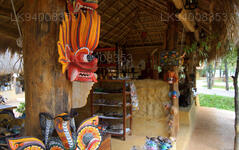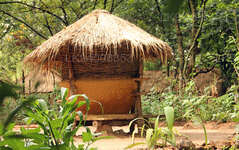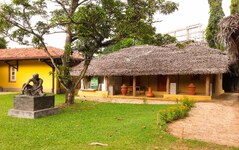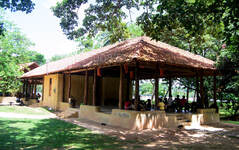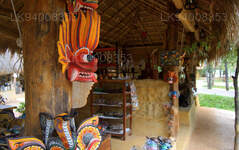
/páginas/transferências
Colombo, a capital do Sri Lanka, é uma cidade dinâmica que mistura tradição e modernidade. Ela exibe arquitetura colonial, mercados animados e templos budistas serenos. Com uma gastronomia diversificada, um horizonte crescente e belas praias, é um centro vibrante de negócios, cultura e turismo, oferecendo uma porta de entrada para explorar as maravilhas do Sri Lanka.
Ape Gama (Our Village; අපේ ගම)
Ape Gama in Sri Lanka: Historical theme Park
Ape Gama in Sri Lanka is a replica of traditional old day Sri Lankan village. This is located in Battaramulla, close to “Diyatha Park”. Ape Gama displays traditional industries, village life style and how self-sufficient old day Sri Lankan society functions in those days.
Formerly, this spot was known as the “Battaramulla Janakala Kendraya” that showcased local crafts. The entire area was revamped for the Commonwealth Heads of Government Meeting (CHOGM) in 2013 to exhibit the fascinating aspects of historic Sri Lankan village life, complete with a bird-watching zone and a mini zoo.
The outstanding recreation of life in a Sri Lankan village has been achieved with precision and attention to detail. It’s not too far from Colombo, situated at the Jana Kala Kendraya in Battaramulla. From the well kempt garden to the many houses made of mud enclosed with wattles, to the figurines of men and women in many postures, the concept has been brought to fruition with much meticulousness. The simplicity and plainness that typifies village living is showcased in all the exhibits.
“Ape Gama in Sri Lanka” attracts throngs of visitors each week seeking a short break in a unique venue.
Ape Gama in Sri Lanka: Village life
Ape Gama is open 365 days of the year from 9 am to 9 pm. And its folk are standing by to explain the many facets of village life. Yes, there are people living in this ‘model’ village attending to everyday tasks for visitors to observe. Karunarathne Mahagamarala is the Headman of this village.
Ape Gama has been constructed as a replica of the old village in Sri Lanka. All the houses are built in a circular form with a ‘meda midula’ or garden at the centre. This is where children used to gather for play while the village was protected along its periphery by the houses. Women folk of Ape Gama are quite busy making and selling Sri Lankan sweetmeats.
A cooking demonstration of sorts take place as women keep themselves busy frying sweets in one pan while sugar and grated coconut is being cooked in another. The demand for these fresh sweets is quite high and the small village ‘boutique’ is finding it difficult to cope with the swelling customers. Women are walking hurriedly to and fro taking the prepared sweets for sale. Visitors finish it off with a cup of herbal drink served in coconut shells. In the meantime the drummer is making music and song seated in the porch of his house.
The houses are separated by fences made of twigs and in some places a narrow bridge made with the trunk of a coconut tree leads to the garden. Varieties of vegetables are grown along the fences. The village is surrounded by trees and tall grass; in one corner of the village is a tree house from where the farmer protects his crops at night.
Ape Gama in Sri Lanka: Arts and Crafts
Beyond Ape Gama is an extension of ‘Sri Lankness’ with many craft houses selling products typically Sri Lankan. The concept is based on creating open spaces just like Ape Gama. Craftsmen work in their outlets making jewellery, carving masks and statues, painting fabric, sewing, making lace and more.
Some of these have been in existence as cottage industries for years and survived for generations. The difference today may be the use of technology and technique, but the elegance remains unchanged. The visitor must take time to go through these craft houses as there is so much to take in.
Ape Gama in Sri Lanka: Visitor Reviews
"It is a very good place for 5th grade school children and for foreigners those who love to see and experience the traditional Sri Lankan lifestyle. The Village Man will explain about the lifestyle and ancient Sinhala vocabulary by giving examples in an interesting manner. Can be experience live clay pot making, wood carving techniques, handmade items along with the..." – Visited January 2017
"Within the park there is Ape Gama a representation of how Sri Lankan villages used to look and operate. There are some classic buildings showing the skill of previous generations in building shelters from the environment. The village is well laid out and easy to stroll around." – Visited April 2016
"Nice paths and scenery to walk around on a nice day. Paths are surrounded by pools of water which look almost natural. Large and small fish can be seen in the water surrounding the paths, but there is a small range of Aquariums nearby filled with several fish. In addition to the small shops (which do not force you to buy stuff) selling plants and aquarium fish, there is also a food stall with a selection of different food to eat."
Sobre o Distrito de Colombo
Colombo é a maior cidade e capital comercial do Sri Lanka. Está localizada na costa oeste da ilha e adjacente a Sri Jayewardenepura Kotte, a capital do Sri Lanka. Colombo é uma cidade movimentada e vibrante, com uma mistura de vida moderna e edifícios e ruínas coloniais, e uma população de 647.100 habitantes. A Região Metropolitana de Colombo, definida pelos distritos de Colombo, Gampaha e Kalutara, tem uma população estimada de 5.648.000 habitantes e cobre uma área de 3.694,20 km². Colombo é uma cidade multiétnica e multicultural. É a cidade mais populosa do Sri Lanka, com 642.163 habitantes vivendo dentro dos limites da cidade. A população de Colombo é uma mistura de vários grupos étnicos, principalmente cingaleses, mouros e tâmeis. Há também pequenas comunidades de pessoas de origem chinesa, portuguesa, holandesa, malaia e indiana vivendo na cidade, bem como numerosos expatriados europeus. A grande maioria das empresas cingalesas tem sua sede em Colombo. Algumas das indústrias incluem produtos químicos, têxteis, vidro, cimento, artigos de couro, móveis e joias. No centro da cidade está localizado o segundo edifício mais alto do sul da Ásia: o World Trade Center.
Sobre o Distrito de Colombo
A Província Ocidental é a província mais densamente povoada do Sri Lanka. Abriga a capital legislativa, Sri Jayawardenepura Kotte, e Colombo, o centro administrativo e comercial do país. A Província Ocidental é dividida em três distritos principais: Colombo (642 km²), Gampaha (1.386,6 km²) e Kalutara (1.606 km²). Como centro econômico do Sri Lanka, todas as grandes corporações locais e internacionais estão presentes na cidade, assim como todos os grandes estilistas e varejistas de rua. Portanto, prepare-se para se deliciar com as compras na Província Ocidental. Com a maior população de todas as províncias, quase todas as principais instituições de ensino da ilha estão localizadas na Província Ocidental. As universidades da província incluem a Universidade de Colombo, a Universidade de Sri Jayewardenepura, a Universidade de Kelaniya, a Universidade Aberta do Sri Lanka, a Universidade Budista e Pali do Sri Lanka, a Universidade de Defesa General Sir John Kotelawala e a Universidade de Moratuwa. A província ocidental tem a maior quantidade de escolas do país, que inclui escolas nacionais, provinciais, privadas e internacionais.

